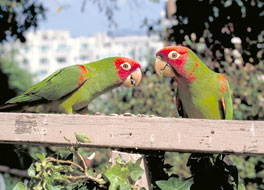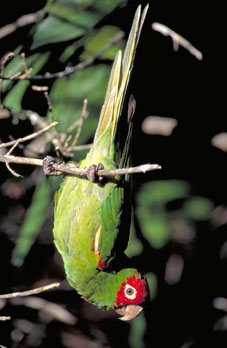 |
Photo by Mark Bittner |
The Wild Parrots of Telegraph Hill
Directed by Judy Irving (2004).
The Wild Parrots of Telegraph Hill soars miles beyond even the best
nature documentary. It’s low-key and unembellished, but don’t
let that fool you. The film’s director, Judy Irving, has made
this is a warm, intelligent and engaging love story. Most intriguing
of all, it’s about wild parrots living in an urban setting—high
on a hill in an exclusive San Francisco neighborhood.
Mark Bittner, the star of the film, is a down-on-his-luck nature-loving, handyman
who is re-evaluating his life. He is pondering the larger questions—like
what’s important, what to do with his life, and why things aren’t
going as planned. He lived on and off the streets for 15 years before getting
a steady job. In exchange for cleaning house and running errands for an elderly
woman, Bittner finally has a steady residence—a run-down but rent-free
cottage with the posh address of Telegraph Hill.
One day, Bittner notices several parrots fluttering about his fire escape. “If
you want to find nature, start where you are,” wrote poet Gary Synder.
Bittner takes these words to heart and spends the next five years befriending
45 Cherry-Headed Conjure parrots who regularly visit his backyard. The flock
consists of former pets (those who escaped or were released by their frustrated
guardians) and a handful of offspring. Born in the wild in Ecuador or Peru, tamed,
and now wild again, they thrive on non-native trees easy to find in cities and
suburbs.
Bittner quickly becomes engrossed in the birds’ behaviors and personalities.
It’s like that popular John Lennon quote: “Life is what happens to
you while you’re busy making other plans.” No doubt Bittner would
agree, as something magical happens with his interactions with these wild parrots.
What is most profound and intriguing is how Bittner gets to know each bird individually.
He gives them names and notices their pairing in couples. It takes a while for
him to detect physical differences. He looks hard until he notices the little
things—a chipped beak on one, uneven red markings on another, the white
around the eyes of a third—things barely distinguishable by the average
person.
Yet, that’s exactly who Bittner is and why I love him. He has no scientific
training and no Ph.D. in environmental science or ornithology. But he has time,
patience, curiosity, an open heart and a boyhood dream of befriending wild animals.
It takes a year before any of the birds will eat out of his hand and longer until
they will perch on his arm, shoulder and head. Gradually, he learns all he can
about his new friends and keeps detailed journals—getting to know Tupelo,
Connor, Olive, Picasso, Mingus, Pushkin, Sophie and the others. In describing
how this unique experience unfolded, director Judy Irving comments, “I
think an attitude of patient focus plus affection opens up enormous worlds,” and
adds, “I think this approach is accessible to everyone.”
It took Irving four and a half years to complete the film and during that time
her assumptions about parrots changed. “I had no idea they had such distinct
personalities,” she commented in a recent interview. “The long filmmaking
process helped me see that ALL animals have personalities, and our blind spot
as humans is that we just don’t normally take the time to notice them.” As
Irving filmed, Bittner wrote.
Mark Bittner’s book, of the same title as the movie, was published in January
2004 and is currently on The New York Times bestseller list. His memoir truly
is about the unexpected ways magic enters our lives and transforms us. The ancients
say that animals are our teachers. Perhaps it is the birds who found Bittner,
and not the other way around. They nurtured him and were his teachers. When it
was his time to fledge, to move on in his life, they let him go.
Irving’s vision for this film is to help people experience “a deep
feeling of the interconnectedness that we all have with the animal world, the
natural world, the world that we don’t think about that much. And one way
of fostering that connection is to just simply look around, even in a city.” The
Wild Parrots of Telegraph Hill is a remarkably nonhuman centered documentary
and yet Bittner’s kindness and compassion never stray far from the movie’s
core. This is a must see for us all.
For more information and a listing of theater screenings, see www.wildparrotsfilm.com.
To learn more about Mark Bittner’s memoir, visit www.wildparrotsbook.com.
Tracy Basile is a freelance journalist who also teaches courses about animals
and nature at Pace University and Purchase College, SUNY.
 |
|
|
 |
|
Finding Wild
Parrots in NYC
 |
Photo by Mark Bittner |
There are quite a few wild parrot flocks in
the tri-state area. Four separate flocks flourish in Brooklyn—at Brooklyn College, in Greenwood Cemetery,
Bensonhurst, and Marine Park. One very large flock thrives in New Jersey
in Edgewater, and three flocks live in Connecticut—in Stamford,
East Norwalk, and Bridgeport.
The majority of these birds are monk parrots. They are usually solid
emerald green in color and prefer large multiple-dwelling condo-style
nests in the tallest
and sturdiest trees—or telephone polls—they can find. For this
reason you will probably never see any flocks in Manhattan, where the telephone
and
power lines are beneath the ground.
Legend has it that the first Brooklyn flock escaped from JFK airport in 1967
after being caught by the thousands in Argentina and shipped to cities all
across the U.S. Perhaps one of the crates shipped to New York City fell while
unloading,
or perhaps the crafty little birds picked the lock. They were first spotted
as a flock in 1971 on the campus of Brooklyn College and have caught people’s
attention—and imagination—ever since.
Undeterred by the cold weather, these parrots are able to survive northeastern
winters. Their impact on the ecosystem is minimal: they get along with pigeons,
starlings, sparrows, etc. and appear to feast on non-native trees that other
birds don’t care for. It’s also worth noting that they didn’t
come here on their own volition: they, or their parents, were captured—either
legally or illegally—to profit the pet industry.
North America once had an indigenous parrot—the Carolina parakeet. But
farmers and hunters who coveted the feathers for women’s hats exterminated
them in the early 20th century. Steve Baldwin, an aficionado of the Brooklyn
flocks, sees the arrival of these wild parrots as a second chance. “In
my view, “ he says, “instead of hassling this creature, we should
be marveling at this miracle.”
And today while most residents enjoy their new, albeit noisy, neighbors,
the power companies typically take a different view. PSE&G across the river prompts
hundreds of activists and bird-loving residents to protest. The parrots there
face eviction due to antiquated legislation that deems these birds “dangerous.” Working
with New Jersey officials, Edgewater-resident Alison Fragale-Evans is spearheading
a campaign to change that (www.edgewaterparrots.com).
Con Edison is the exception, which now hosts a parrot-friendly policy that includes
removing only those nests that threaten to cause fires or brownouts, taking precautions
when handling babies, working with parrot rescue groups, and welcoming suggestions
on experimental pole designs that can accommodate the parrots and the power.
“ They’re very interesting to watch,” says Baldwin, who considers
his feathered friends little New Yorkers. “They travel in pairs, and you’ll
often see them preening or kissing each other. They also fight and argue, even
steal twigs from each other’s nests,” he says.
Baldwin, a former editor of PC magazine, got hooked observing the
parrots this past winter and now runs a website devoted to stories, news
events and
photos
about the birds. He also gives free parrot tours. To learn more, visit www.brooklynparrots.com.—T.B.
|


